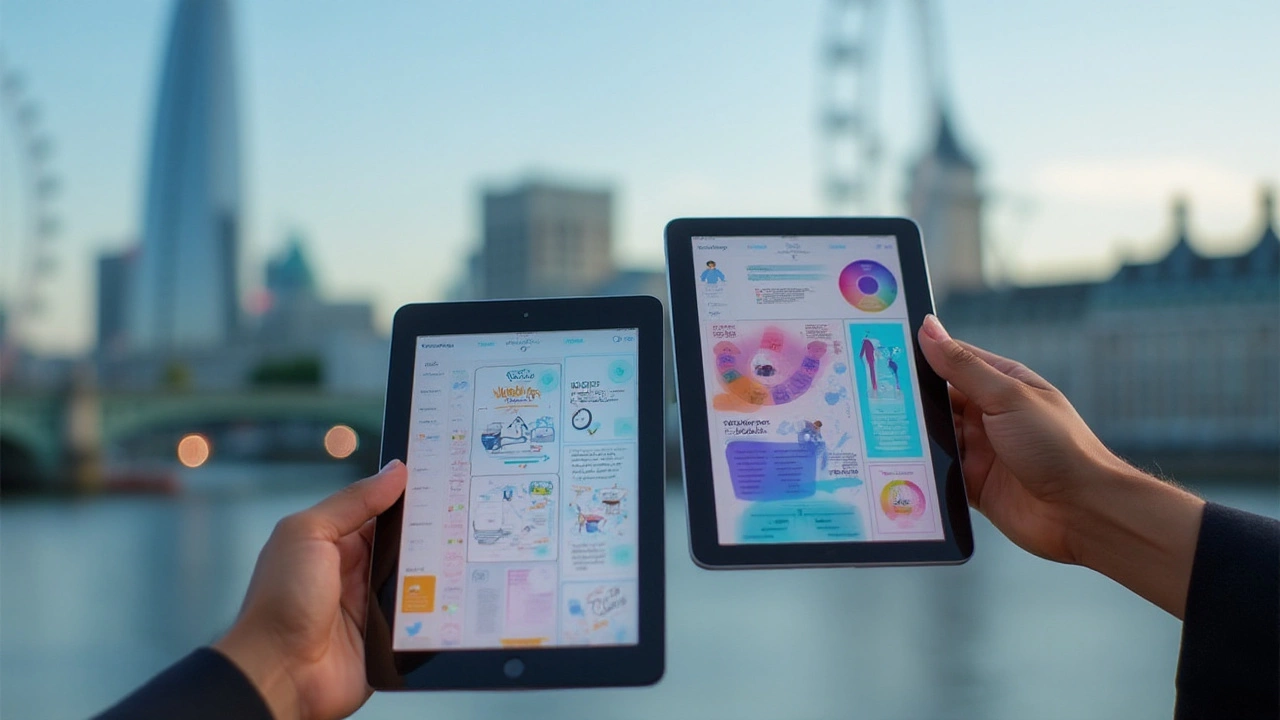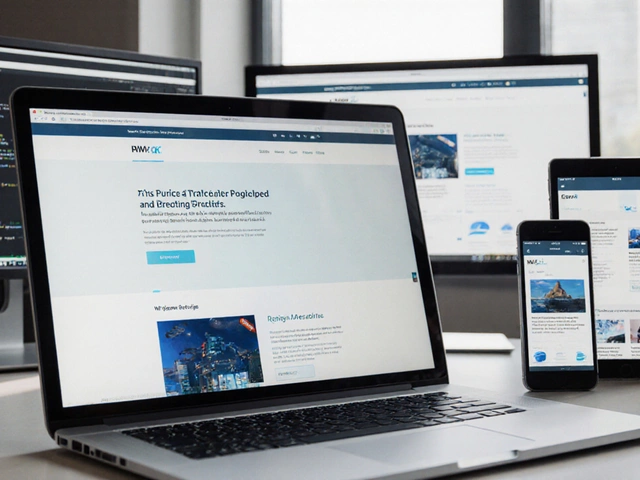The question of whether UX design or UI design pays more is one that many budding designers often ponder. With the ever-evolving tech landscape, both fields have seen substantial growth and change in recent years, making the salary debate even more intriguing. Understanding not just the financial rewards, but also the nuances of each role, can guide career decisions significantly.
As of 2025, there are distinct trends and statistics that provide insights into the earning potential in these professions. The demand for skilled designers who can create and optimize user experiences and interfaces is high, but certain factors can sway earning potential one way or the other. From industry niches to location and experience level, these elements can deeply influence how much one can make in either field. This article aims to shed light on these aspects, offering a comprehensive view of what aspiring designers can expect financially.
- Introduction to UX and UI Roles
- Current Salary Trends and Data
- Factors Influencing Salary Differences
- Tips for Maximizing Earnings in Design
Introduction to UX and UI Roles
The roles of UX and UI designers, though closely intertwined, involve distinct responsibilities and require different skill sets. Understanding these differences can be key to determining the potential salary each role offers. The UX design salary often reflects a focus on the user’s journey, while UI design salaries align with the aesthetic elements users interact with.
What is UX Design?
UX design, or User Experience design, revolves around optimizing how users interact with products or services. This discipline focuses on the entire process of acquiring, integrating, and functioning within a product. UX designers conduct thorough research to understand user needs and pain points. They sketch wireframes, develop prototypes, and take usability tests to ensure a seamless user experience. As psychological aspects of human interaction heavily guide this role, UX designers need to possess strong empathy, analytical thinking, and problem-solving skills. The end goal is to make users' experiences as smooth and intuitive as possible. A UX designer typically engages in various tasks aimed at enhancing user satisfaction by improving the usability and accessibility provided in the interaction with the product.Moreover, with the rise of digital products, the demand for skilled UX designers has only soared. Companies are increasingly infusing resources into learning what makes their users tick to stay competitive. This emphasis on optimizing user journeys forms the backbone of the demand for UX design professionals in every industry. As noted by a senior analyst in digital interface trends, "In today's dynamic marketplace, user experience is key to differentiating brands in the eyes of tech-savvy consumers."
What is UI Design?
On the other hand, UI design, or User Interface design, is all about the visual feel and interactive elements that make up digital platforms. UI designers work with the typography, imagery, buttons, icons, and other visual touch points in a product. Their task is to translate the UX designer's plans into a visual story that resonates with brand identity while being user-friendly. UI professionals thrive on creativity and artistic skills and have a keen eye for detailed aesthetics that engage the user instantly from their screens.Emphasis is placed on creating an interface that users find visually pleasing and easy to use. Coupled with an in-depth knowledge of design principles, color theory, and branding, UI designers breathe life into the static designs provided by UX teams. They might spend hours tweaking the look of a button until it closely matches the brand's intent, looking beautiful and functional on a range of devices. The bottom line for UI is about creating harmony between all elements, making sure that each piece works in perfect sync with the user’s needs and expectations.
The UI/UX professions are collaborative by nature, needing solidarity between the two for a digital product to not just function effectively but also appeal aesthetically. Each role holds its own merits and complexities, revealing distinct pathways for career and financial growth.

Current Salary Trends and Data
When exploring the financial rewards in the world of UI and UX design salary, one can't ignore the current trends shaping the industry. A significant factor influencing these trends is how businesses are increasingly prioritizing user experience in their products. This shift has cultivated a dynamic environment where skilled designers are in high demand, albeit with varying pay scales depending on the design focus.
Diverse Pay Scales: UX versus UI
One noticeable trend is the diversity in pay scales between UX designers and UI designers. In areas where technology companies dominate, such as Silicon Valley, the UX design salary often surpasses that of UI. The reasoning ties back to the complexities involved in UX design, which requires a comprehensive understanding of user behavior, psychology, and analytics to create seamless experiences."Businesses realize the value of rich user experience, and as a consequence, UX designers who can bring this to life are seeing their stock continue to rise." - Design Week MagazineStatistics have shown that senior UX roles in established tech hubs can command anywhere from $100,000 to well over $150,000 annually. As UI design is more focused on the aesthetic layer of digital interfaces, the pay often starts closer to $80,000, with potential to grow based on skills and industry requirements.
Regional Variations
While these figures provide a generalized picture, it's critical to consider the regional differences. Designers in areas with a sprawling tech scene, such as New York or San Francisco, enjoy higher median salaries compared to those in smaller cities. However, this isn't the only determinant; cost of living also plays a significant role in how enticing these figures truly are. Remote work paradigms have slightly evened out these discrepancies, yet differences remain significant, especially in emerging markets.The Impact of Experience and Specialization
Another layer impacting salaries is the level of experience and specialization. Junior roles typically present entry points with competitive packages, but the opportunity for a substantial increase is often seen with specialization in niche areas. Designers with expertise in voice user interfaces or AR have stepped into a realm where salary negotiations start on a higher pedestal. Professional growth pathways are crucial here, as they define how quickly one can move up the earning ladder.Gender Pay Gap
On the flip side, the gender pay gap has been a pertinent issue across many professions, including UX/UI. Studies frequently underline the disparity, even as companies pledge equality. As per a 2023 report, the gap, albeit narrower than in years past, still shows discrepancies that need addressing.Compensation Beyond Salaries
Lastly, looking beyond the stated salary can reveal other forms of compensation. Many companies offer stock options, bonuses, and benefits packages, rounding out the total compensation in ways that can make up for any base salary shortfall. Understanding these elements is crucial for ensuring informed career choices in this prospering industry.
Factors Influencing Salary Differences
When discussing the differences in salaries between UX design and UI design, it's essential to recognize the various factors that contribute to these variances. One significant factor is the level of expertise and experience within each domain. Experienced designers, regardless of their specific focus, command higher salaries due to their extensive knowledge and proven track records in delivering user-centered solutions. However, individuals with a deeper understanding of user research, experience design, or interface development might find themselves in more lucrative positions.
Another element affecting salaries is the geographic location where a designer pursues their career. Cities known as tech hubs, such as San Francisco, New York, and London, tend to offer higher salaries to accommodate the higher cost of living in these areas. In contrast, designers in smaller cities or areas with less tech industry presence might see lower salary offers. A survey conducted by Design Professionals Network indicated that salaries for UX/UI roles in the U.S. can differ by as much as 30% based on location alone. This highlights the importance of considering not just the salary but the entire compensation package and cost of living in a particular area.
Industry specialization also plays a critical role in determining earning potential. Designers working in niche industries like healthcare, fintech, or educational technology might find unique opportunities that offer premium salaries due to the specialized knowledge required. These fields often demand specific design skills and familiarity with industry regulations, significantly influencing the hiring company's willingness to pay top-tier salaries. According to the Design Industry Salary Report, those specializing in the fintech sector might earn an average of 15% more than their counterparts in more traditional sectors.
"Designers who can blend technical skills with business acumen and industry-specific insights will always find their expertise in high demand," says Jane McAdams, author of Designing The Future.
Lastly, the demand for certain skills can fluctuate, directly impacting salary levels. As technology evolves, new tools and methods emerge, requiring designers to constantly update their skillsets. Those proficient in the latest design software or who have expertise in emerging areas such as AI integration or VR platform design see a noticeable salary boost. Employers are ever eager to cater to users' changing needs, and designers who stay ahead of these trends will undoubtedly be rewarded. This constant evolution makes continuous learning and adaptation crucial traits for sustaining a competitive edge in the UX and UI fields.

Tips for Maximizing Earnings in Design
For anyone working in UX design or UI design, maximizing earnings can be an enticing goal. There are several proven strategies to enhance one’s financial prospects in this industry. The first step is continuous learning and skill enhancement. Given that technology evolves rapidly, staying updated with the latest tools and trends is crucial. Many successful designers invest time in learning new design software, mastering advanced techniques, and understanding user psychology. By doing so, they not only build robust portfolios showcases of their skills but also keep up with industry standards, which is invariably beneficial during salary discussions with potential employers.
Networking is another vital aspect. Attending industry conferences, participating in online forums, and joining local design meetups can open doors to new opportunities. Building a strong network means you have access to a wealth of knowledge and a continuous feed of job openings. Often, job opportunities with higher salaries come through recommendations or while switching companies. UX designers and UI designers should never underestimate the power of word-of-mouth and personal recommendations, which can significantly enhance one’s earning potential. Joe Smith, a renowned career coach, aptly notes, "For designers, it’s crucial to be seen and be known in the right circles. It's not just about what you know, but who you know."
Certifications can be invaluable in establishing expertise in specific areas of design. Certifications from reputable organizations can serve as tangible evidence of your skills to potential employers. They not only boost your credibility but can also lead to better pay scales. Employers are often willing to pay a premium for certified professionals because these certifications signify a commitment to the craft and a benchmark of quality and skill. For instance, certifications in tools like Sketch, Adobe XD, or even user research methodologies are increasingly sought after in both fields.
Freelancing offers another avenue for boosting income. Many designers supplement their full-time jobs with freelance projects. This practice not only offers financial benefits but also enriches one's experience through exposure to varied projects and clients. With freelancing, designers can set their own rates, often higher than the typical salaried job would pay. A savvy approach to freelancing involves researching the market rates for different projects and adequately valuing one's experience and expertise. When offering freelance services, building a niche can sometimes command a higher pay.
Geographical location can impact earnings significantly. For designers willing to relocate or work remotely, seeking employment in locations known for offering higher compensation in the design sector can be a game changer. Major tech hubs like San Francisco, New York, and London are known for their competitive salaries. On the other hand, remote work platforms now allow designers to tap into these markets without geographical constraints. According to a recent survey by Design Update Magazine, the average salary for UX designers in San Francisco is 40% higher than in many other U.S. regions.
Understanding market trends and adapting to shifts in demand are also critical in maximizing earning potential. The ability to pivot towards the latest market demands—be it accessibility design, voice interface design, or any emerging technology—can make you indispensable. This adaptability is highly valued and often comes with increased salary prospects because it shows employers that you are forward-thinking and capable of tackling future challenges.





